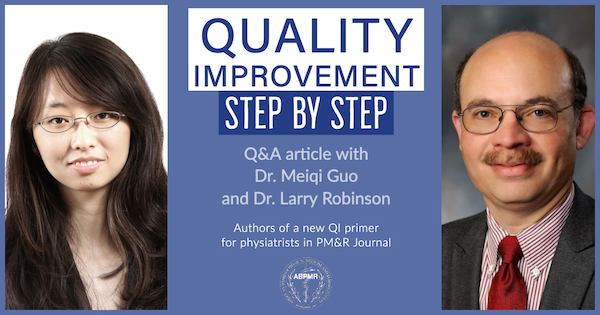CC
A Q&A about QI: Steps for Quality Improvement

In the July 2019 issue of PM&R (Vol. 11, Issue 7), one article in particular caught the ABPMR’s eye: Quality Improvement in Rehabilitation: A Primer for Physical Medicine and Rehabilitation Specialists (click to read the abstract) by M. Guo et al.
In this article, the authors, which includes ABPMR board director Dr. Larry Robinson, offer a step-by-step guide to quality improvement (QI) in rehabilitation settings for academic and community physiatrists, including using a specific QI project (secondary prevention of vascular complications in amputees with diabetes admitted to an inpatient setting) as an illustrative example throughout.
We reached out to Drs. Guo and Robinson to expand on their process writing this primer, how they think of QI in rehabilitation settings, and their recommendations for fellow physiatrists embarking on a QI project (perhaps for MOC Part IV credit). Below are their responses to our questions.
Thank you, Dr. Guo and Dr. Robinson, for providing such a comprehensive guide to QI for physiatrists!
1. What initially piqued your interest in looking into QI in rehabilitation settings, and how did it turn into a ‘Primer?’
Several years ago, our University of Toronto PM&R faculty realized we needed to develop core skills in QI and a critical mass of QI experts. This became an integral part of our strategic plan, which ultimately resulted in cross-hospital QI projects. The primer idea resulted from a multi-hospital QI project in the Division of PM&R, during which we realized that many physiatrists were interested in improving care, but also that QI is a relatively new field. So, we created a QI basics primer that would help our physiatry colleagues to participate in and lead QI endeavours.
2. In the introduction you say “In our opinion, there is a pressing need for the field of [PM&R] to embrace QI in a more systematic and widespread manner.” Why is this a ‘pressing need’ for physiatry in particular?
There is much we can improve in medicine in general in terms of making care safer, more efficient, patient-centered, timely, and effective. This has been traditionally a focus of internal medicine and surgery, but the field of PM&R is really no different. In fact, by virtue of our practice, we have special opportunities to make the QI approach truly interdisciplinary that other fields don’t have. At the same time, we believe there is a gap in QI expertise in PM&R compared to some other fields, which we hope to help close. Increasing attention to quality and safety from accrediting bodies, payers, hospitals, regulators, and patients/families makes this need more pressing. Care can always be better, and we hope that physiatrists will be leaders in improving rehabilitation care.
3. What are the unique aspects of QI particular to the characteristics of the specialty of PM&R?
Physiatrists closely collaborate with other healthcare providers on a regular basis. Our ability to work in and lead teams allows us to more broadly engage others and receive “buy-in” for our QI projects. Physiatrists also typically follow patients longitudinally, which allows more opportunity to engage patients as active participants in QI projects, from providing feedback on the project’s change ideas to participating as a member of the QI team. Lastly, QI projects in rehabilitation often fall more within the Institute of Medicine’s patient-centeredness domain of quality, which is unique when compared to other specialties’ typical projects. For example, we may choose to work on a project to improve our patients’ sexual health or patients’ experience of goal setting in rehabilitation.
4. In the primer you point to a few QI tools such as a gap analysis, fishbone diagram, pareto chart, and process mapping. Sometimes these tools can feel overwhelming to a physician outside the QI space. Are these tools options on a menu of options, or should a physiatrist really understand each one in depth before embarking on a project?
It is not necessary to understand each tool in depth before embarking on a project. These tools are simply instruments to consider as one embarks on a QI journey. Physiatrists conducting a QI project should be aware that these tools exist and use one or more of them with more in-depth reading on an as-need basis through their QI journeys. These tools are relatively straightforward to learn with “on the job training.” Thus, we also encourage those may be inexperienced to seek help from more experienced colleagues, or the quality/safety department at their institutions. Once they start using these tools, they may find that they are actually fun to employ (when else do we get to draw a fish skeleton at work?).
5. Dr. Robinson, in your view, what is the importance of the ABPMR requiring QI as part of its MOC requirements? What role does a certifying board play in the QI space?
The trajectory of medicine over the last couple of decades has included an increasing focus on QI skills. These are increasingly necessary for work in hospital settings as well as academic centres. But they are also very useful for those wishing to improve their skills, performance and outcomes in ambulatory practice settings.
The American Board of Medical Specialities (ABMS), of which ABPMR is a member board, has led development of QI integration into accreditation processes. Having seen a number of very impressive practice improvement projects (PIPs) that our ABPMR diplomates have submitted as part of the process, I believe these can be excellent opportunities to develop and implement QI skills in our practices.



